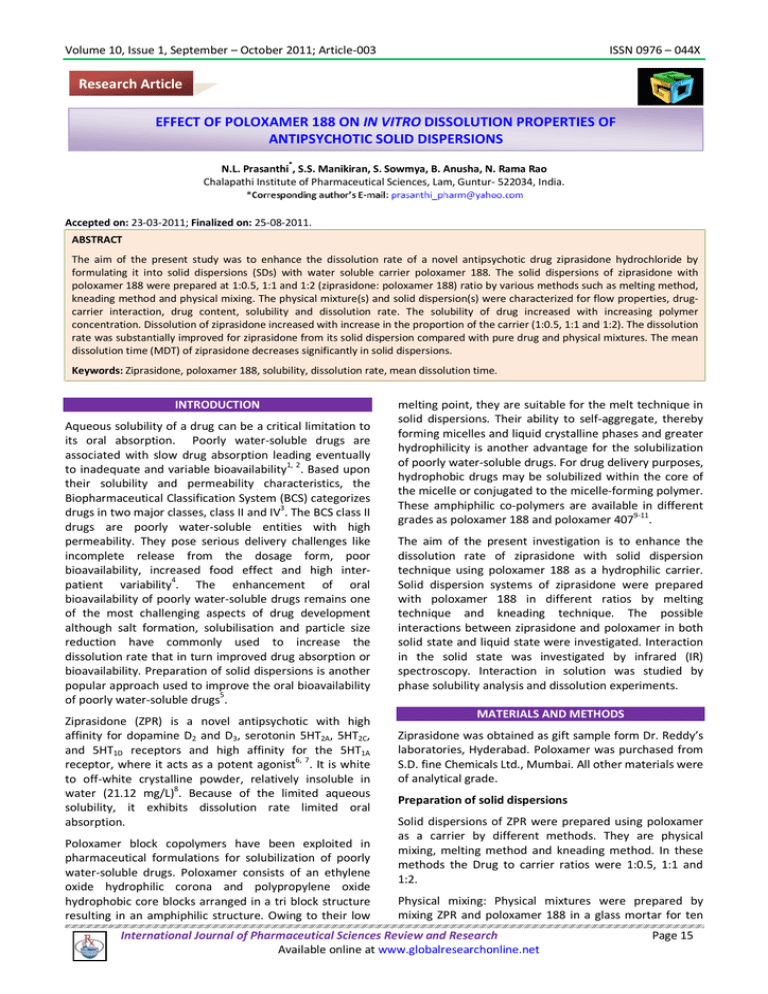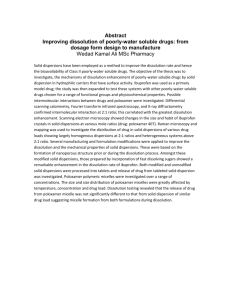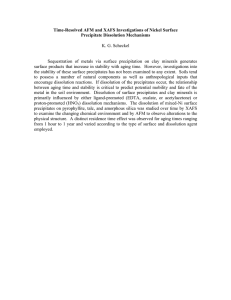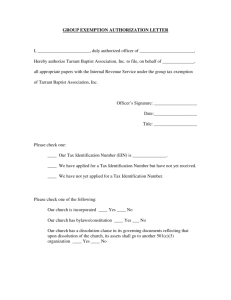Document 13308101
advertisement

Volume 10, Issue 1, September – October 2011; Article-003 ISSN 0976 – 044X Research Article EFFECT OF POLOXAMER 188 ON IN VITRO DISSOLUTION PROPERTIES OF ANTIPSYCHOTIC SOLID DISPERSIONS * N.L. Prasanthi , S.S. Manikiran, S. Sowmya, B. Anusha, N. Rama Rao Chalapathi Institute of Pharmaceutical Sciences, Lam, Guntur- 522034, India. Accepted on: 23-03-2011; Finalized on: 25-08-2011. ABSTRACT The aim of the present study was to enhance the dissolution rate of a novel antipsychotic drug ziprasidone hydrochloride by formulating it into solid dispersions (SDs) with water soluble carrier poloxamer 188. The solid dispersions of ziprasidone with poloxamer 188 were prepared at 1:0.5, 1:1 and 1:2 (ziprasidone: poloxamer 188) ratio by various methods such as melting method, kneading method and physical mixing. The physical mixture(s) and solid dispersion(s) were characterized for flow properties, drugcarrier interaction, drug content, solubility and dissolution rate. The solubility of drug increased with increasing polymer concentration. Dissolution of ziprasidone increased with increase in the proportion of the carrier (1:0.5, 1:1 and 1:2). The dissolution rate was substantially improved for ziprasidone from its solid dispersion compared with pure drug and physical mixtures. The mean dissolution time (MDT) of ziprasidone decreases significantly in solid dispersions. Keywords: Ziprasidone, poloxamer 188, solubility, dissolution rate, mean dissolution time. INTRODUCTION Aqueous solubility of a drug can be a critical limitation to its oral absorption. Poorly water-soluble drugs are associated with slow drug absorption leading eventually to inadequate and variable bioavailability1, 2. Based upon their solubility and permeability characteristics, the Biopharmaceutical Classification System (BCS) categorizes drugs in two major classes, class II and IV3. The BCS class II drugs are poorly water-soluble entities with high permeability. They pose serious delivery challenges like incomplete release from the dosage form, poor bioavailability, increased food effect and high interpatient variability4. The enhancement of oral bioavailability of poorly water-soluble drugs remains one of the most challenging aspects of drug development although salt formation, solubilisation and particle size reduction have commonly used to increase the dissolution rate that in turn improved drug absorption or bioavailability. Preparation of solid dispersions is another popular approach used to improve the oral bioavailability of poorly water-soluble drugs5. Ziprasidone (ZPR) is a novel antipsychotic with high affinity for dopamine D2 and D3, serotonin 5HT2A, 5HT2C, and 5HT1D receptors and high affinity for the 5HT1A 6, 7 receptor, where it acts as a potent agonist . It is white to off-white crystalline powder, relatively insoluble in water (21.12 mg/L)8. Because of the limited aqueous solubility, it exhibits dissolution rate limited oral absorption. Poloxamer block copolymers have been exploited in pharmaceutical formulations for solubilization of poorly water-soluble drugs. Poloxamer consists of an ethylene oxide hydrophilic corona and polypropylene oxide hydrophobic core blocks arranged in a tri block structure resulting in an amphiphilic structure. Owing to their low melting point, they are suitable for the melt technique in solid dispersions. Their ability to self-aggregate, thereby forming micelles and liquid crystalline phases and greater hydrophilicity is another advantage for the solubilization of poorly water-soluble drugs. For drug delivery purposes, hydrophobic drugs may be solubilized within the core of the micelle or conjugated to the micelle-forming polymer. These amphiphilic co-polymers are available in different grades as poloxamer 188 and poloxamer 4079-11. The aim of the present investigation is to enhance the dissolution rate of ziprasidone with solid dispersion technique using poloxamer 188 as a hydrophilic carrier. Solid dispersion systems of ziprasidone were prepared with poloxamer 188 in different ratios by melting technique and kneading technique. The possible interactions between ziprasidone and poloxamer in both solid state and liquid state were investigated. Interaction in the solid state was investigated by infrared (IR) spectroscopy. Interaction in solution was studied by phase solubility analysis and dissolution experiments. MATERIALS AND METHODS Ziprasidone was obtained as gift sample form Dr. Reddy’s laboratories, Hyderabad. Poloxamer was purchased from S.D. fine Chemicals Ltd., Mumbai. All other materials were of analytical grade. Preparation of solid dispersions Solid dispersions of ZPR were prepared using poloxamer as a carrier by different methods. They are physical mixing, melting method and kneading method. In these methods the Drug to carrier ratios were 1:0.5, 1:1 and 1:2. Physical mixing: Physical mixtures were prepared by mixing ZPR and poloxamer 188 in a glass mortar for ten International Journal of Pharmaceutical Sciences Review and Research Available online at www.globalresearchonline.net Page 15 Volume 10, Issue 1, September – October 2011; Article-003 minutes. The resulting mixture was sieved through # 100 and then stored in a desiccator at room temperature until use. Melting method: Solid dispersions were prepared by melting the physical mixture of ZPR and poloxamer 188 in a sand bath. The fusion temperature was controlled between 60-70°C. The molten mixture was immediately cooled and solidified in an ice bath with vigorous stirring. The solid obtained was scrapped, crushed, pulverized and passed through #100. The obtained product was stored in a desiccator. Kneading method: ZPR was dissolved in methanol and this solution was added to aqueous solution of poloxamer 188, which was prepared by dissolving poloxamer 188 in water. Then the mixture was triturated in a glass mortar until it was dried. The dried powder was passed through #100 and the final product was stored in a desiccator. Characterization of Dispersions of ZPR Physical Mixtures and Solid Phase Solubility Studies Solubility determinations were performed in triplicate according to the method of Higuchi and Cannors12. The effect of concentrations of poloxamer 188 on the equilibration solubility of ziprasidone in water at room temperature was carried out by adding an excess of drug (50 mg) in to a screw-capped glass vial containing 10 ml of water and various amounts of the carrier (2-10% w/v). The samples were placed on a rotary shaker and agitated at room temperature for 48 h. An aliquot of each solution was withdrawn and filtered through a 0.45 µm pore size Millipore membrane filter fitted with syringe holder. The assay of ziprasidone was determined spectrophotometrically at 219 nm. ISSN 0976 – 044X Drug content Drug content was determined by dissolving solid dispersion equivalent to 5mg of the ZPR in small quantity of methanol and kept in ultrasonicator for 10min. The volume was adjusted to 50mL with 1% SLS in phosphate buffer pH 7.4. The solution was filtered through Whatman filter paper no.41, suitably diluted and the absorbance was measured at 219nm using double beam UV spectrophotometer. In-vitro dissolution studies In-vitro dissolution studies of ziprasidone in pure drug form, SDs and physical mixtures were performed by using the US Pharmacopoeia (USP) model digital tablet dissolution test apparatus-2 (Lab India, DISSO 2000) at the paddle rotation speed of 50 rpm in 900 mL of 1% SLS in phosphate buffer pH 7.4. The dissolution rate was studied by placing ziprasidone 20 mg or SDs, PMs equivalent to 20 mg of drug on the surface of dissolution medium. A 5 ml aliquot was withdrawn at different time intervals, filtered (through 0.45µ) and replaced with 5 ml of fresh dissolution medium. The samples were estimated for dissolved ziprasidone by measuring absorbance at 219 nm. The dissolution experiments were conducted in triplicate. Khan suggested dissolution efficiency (DE) as a suitable parameter for the evaluation of in vitro dissolution data. Dissolution efficiency is defined as the area under dissolution curve up to a certain time ‘t’ expressed as percentage of the area of the rectangle described by 100% dissolution in the same time 11. Micromeritic Properties Infrared spectroscopy The flow properties of PMs and SDs were characterized in terms of angle of repose, Carr index and Hausner ratio13. For determination of angle of repose (θ), the sample was poured through the walls of a funnel, which was fixed at a position such that its lower tip was at a height of exactly 2.0 cm above hard surface. The sample was poured till the time when upper tip of the pile surface touched the lower tip of the funnel. The tan-1 of the (height of the pile/radius of its base) gave the angle of repose14. Sample was poured gently through a glass funnel into a graduated cylinder cut exactly to 10 ml mark. Excess sample was removed using a spatula and the weight of the cylinder with powder required for filling the cylinder volume was calculated. The cylinder was then tapped from a height of 2.0cm until the time when there was no more decrease in the volume. Bulk density (ρb) and tapped density (ρt) were calculated. Hausner ratio (HR) and Carr’s index (IC) were calculated according to the two equations given below: Fourier transform infra red (FTIR) spectra were obtained by using Shimadzu FTIR-281 spectrophotometer. The samples (ziprasidone, or SDs or PMs) were previously ground and mixed thoroughly with potassium bromide, an infrared transparent matrix, at 1:100 (sample: KBr) ratio, respectively. The KBr discs were prepared by compressing the powders at a pressure of 5 tons for 5 min in a hydraulic press. The scanning range was 4004000 cm-1 and the resolution was 1 cm-1. HR= ρt/ρb IC = (ρt– ρb)/ρt RESULTS AND DISCUSSION Solid dispersions of ZPR were prepared by physical mixing, melting method and kneading method using poloxamer 188 as carrier in different drug, carrier ratios of 1:0.5, 1:1 and 1:2. The prepared solid dispersions were evaluated for their flow properties. Angle of repose was in the range of 28.71 to 36.87, Carr’s index was found to be 18.52 to 24.18. These values indicate that the particles of solid dispersions exhibited poor flow properties which suggest addition of glidants during formulation of solid dosage form employing solid dispersion of ziprasidone. International Journal of Pharmaceutical Sciences Review and Research Available online at www.globalresearchonline.net Page 16 Volume 10, Issue 1, September – October 2011; Article-003 The drug content was found in the range of 98.6 to 100.3% indicating the acceptability of method for preparation of solid dispersions. Low values of standard ISSN 0976 – 044X deviation in drug content of PMs and SDs indicated uniform drug distribution in all the prepared batches. The values are given in Table 1. Table 1: Drug Content and Micrometric Properties of Ziprasidone Solid Dispersions Code Ratio Drug content (%) Angle of repose Bulk density (g/mL) Tap density (g/mL) Carr’s index (IC) ZP1 1:1 99.6 ± 1.1 29.32±0.52 0.585 0.718 18.52 ZP2 1:2 98.7 ± 1.7 32.54±0.24 0.569 0.708 19.63 ZP3 1:4 97.8± 2.1 34.31±1.02 0.613 0.784 21.81 ZM1 1:1 98.8 ± 0.5 31.54±0.29 0.569 0.689 19.41 ZM2 1:2 98.6 ± 1.2 36.87±0.13 0.613 0.781 21.51 ZM3 1:4 99.3 ± 1.5 31.12±0.18 0.612 0.786 22.13 ZK1 1:1 99.5± 1.1 28.71±1.09 0.534 0.698 23.49 ZK2 1:2 100.3± 0.5 34.56±0.47 0.569 0.702 19.10 ZK3 1:4 99.6± 1.2 33.21±0.55 0.605 0.798 24.18 Table 3: In vitro dissolution parameters of ziprasidone and its solid dispersions Dissolution parameters Formulation First order T50 (min) % DE30min MDT30 2 r ‘k’ ZPR 0.991 0.0138 >50 9.43 15.38 ZP1 0.992 0.0234 30.13 19.86 12.36 ZP2 0.987 0.0299 23.11 25.67 11.23 ZP3 0.982 0.0414 16.74 34.56 10.68 ZM1 0.994 0.0441 15.75 37.86 10.97 ZM2 0.989 0.0582 11.95 43.68 10.13 ZM3 0.983 0.0834 8.35 51.23 8.97 ZK1 0.977 0.0714 9.71 47.89 10.23 ZK2 0.989 0.1014 6.86 59.68 8.76 ZK3 0.932 0.1663 4.17 64.53 6.53 The effect of poloxamer 188 concentration upon the solubility of ZPR is presented in Table 2 and depicted in Figure 1. Table 2: Effect of poloxamer 188 concentration on solubility of ziprasidone Concentration of Concentration of ziprasidone poloxamer (% w/v) (mg/ml) at 37oC 0 0.021 1 0.089 2 0.234 3 0.564 4 0.968 5 1.567 6 1.987 Figure 1: Solubility graph of ziprasidone in water The increase in solubility was linear with respect to the weight fraction of the carrier. The solubility of drug was increased up to 48 fold in 5% w/v poloxamer 188 aqueous solution at 25°C compared with pure drug. The increase in solubility with increasing poloxamer concentration indicates the solvent properties of poloxamer 188 for the drug. Poloxamer 188 causes a decrease of interfacial tension between the drug and dissolution medium. These results could be explained that the reduction in crystallinity of drug led to a decrease of the energy required in the dissolving process and also to a highly dispersed state of the drug. The dissolution rate of ZPR from various solid dispersions was studied in 1% SLS in phosphate buffer pH 7.4. The dissolution of ZPR from all the solid dispersions was rapid and more than the pure drug. The dissolution data was fitted into zero order and first order to assess the kinetics and mechanism of dissolution. The model that gave higher ‘r’ value was considered as the best fit model. The ‘r’ values were found to be higher in the first order model than zero order. The dissolution data is given in Table 3. The dissolution of pure ziprasidone is very low about 34.5% in 60 min. The results of the dissolution study indicate an improvement of dissolution rate of ziprasidone in solid dispersions. The rate of dissolution increases as concentration of poloxamer 188 increases in International Journal of Pharmaceutical Sciences Review and Research Available online at www.globalresearchonline.net Page 17 Volume 10, Issue 1, September – October 2011; Article-003 ISSN 0976 – 044X solid dispersions and it also depends upon method of preparation. The improvement of dissolution rate is possibly caused by several factors. Such factors are a) the strong hydrophilic character of poloxamer 188, which improves the water penetration and the wettability of the hydrophobic ziprasidone b) the optimal dispersion of ziprasidone to poloxamer 188 c) the absence of crystals corresponds to lower energy required for dissolution and d) the inter molecular hydrogen bonds and the molecular dispersion of ziprasidone on poloxamer leads to partial miscibility, improving the hydrophilic characteristics of the drug substance via interaction within the polymer. The improvement of dissolution rate of ziprasidone in PMs is due to increased wettability of the drug powder. DE30 values were calculated in each case as per Khan et.al., for comparative analysis of all formulations Solid dispersions formulated with all the methods exhibited significant improvement in the dissolution parameters of ZPR. The increase in dissolution rate is in the order of kneading method > melting method > physical mixing. The dissolution data is shown in the Figures 2, 3, 4 and 5. From all the formulations, the maximum dissolution was documented for the drug to the carrier ratio of 1:2. Figure 4: In vitro dissolution profiles of ziprasidone and solid dispersions prepared by kneading method Figure 5: Comparative in vitro dissolution profiles of solid dispersions (1:2) prepared by three methods with pure drug. Figure 2: In vitro dissolution profiles of ziprasidone and physical mixtures In order to understand the extent of ziprasidone dissolution rate enhancement from its SDs and PMs, the obtained dissolution data of pure ziprasidone, SDs and PMs were fit in the equation, 15 n MRTin vitro = Σ Tmid ∆M / I=1 n Σ ∆M I =1 IR spectra of ziprasidone showing the peaks at 3412 cm-1 for NH, 2928 cm-1 for CH, 1714 cm-1 for C═O, 1629 cm-1 for C═N, 1528 cm-1 for C═C, 1383 cm-1 for CN and 744 cm1 for C-Cl were all observed in the spectra of ziprasidone as well as its solid dispersions and in physical mixtures with poloxamer 188. Thus, these results ratify the absence of any well-defined interaction between ziprasidone and poloxamer 188. Figure 3: In vitro dissolution profiles of ziprasidone and solid dispersions prepared by melting method International Journal of Pharmaceutical Sciences Review and Research Available online at www.globalresearchonline.net Page 18 Volume 10, Issue 1, September – October 2011; Article-003 CONCLUSION The solubility and dissolution rate of ziprasidone can be enhanced by the use of SDs of ziprasidone with poloxamer 188. The solubilization effect of POLOXAMER 188 is due to reduction of particle aggregation of the drug, absence of crystallinity, increased wettability and dispersibility and alteration of the surface properties of the drug particles might be responsible for the enhanced solubility and dissolution rate of ziprasidone from its solid dispersions and physical mixtures. Acknowledgements: The authors are thankful to Chalapathi Educational Society, Guntur for providing the necessary facilities. REFERENCES 1. Amidon, G. L., Lennernasw, H., Shah, V. P., Crison JR. Theoretical basis for a biopharmaceutical drug classification: the correlation of in vitro drug product dissolution and in vivo bioavailability. Pharm. REs. 1995, 12, 413-420. 2. Leuner, C., Dressman, J., Improving rug solubility for oral delivery using solid dispersions. Eur. J.Pharm. Biopharm. 2000, 50, 47-60. 3. US FDA. Guidelines for industry, Waiver of in vivo bioavailability and bioequivalence studies for immediate release solid oral dosage forms based on a biopharmaceutics classification system., Center for Drug Evaluation and Research, Fishers Lane, Rockville, MD August 2000; 1-13. 4. Lobenberg, R., Amidon, G.L., Modern Bioavailability, Bioequivalence and Biopharmaceutics Classification System; New Scientific Approaches to International Regulatory Standards Eur. J. Pharm. Biopharm. 2000, 50, 312. ISSN 0976 – 044X 5. Sekiguchi K, Obi N. Studies on absorption of eutectic mixture I. A comparison of the behaviour of eutectic mixture of sulfathiazole and that of ordinary sulfathiazole in man. Chem Pharm Bull. 9; 1961: 866-872. 6. Martindale. The Extra Pharmacopoeia. 31 Ed. London: Pharmaceutical press, 2002. 7. Goodman and Gilman. The pharmacological basis of th therapeutics. 10 Ed., McGraw-Hill, 2001. 8. Deshmukh SS, Potnis VV and Kute AB. Developmetn of dissoluiton medium from ziprasidone hydrochloride. Indian Pharmacist. 2006; V (47): 79-80. 9. SC Shin; CW Cho, physico chemical characterization of piroxicam-poloxamer solid dispersions. Pharm. Dev. Tech., 1997, 2, 403- 407. st 10. SR Vippagunta; KA Maul; S Tallavajhala; DJW Grant. Enhancing the dissolution rate of poorly water soluble drug nifedipine. Int. J. Pharm., 2002, 236, 111-123. 11. A Wade; PJ Weller; Handbook of Pharmaceutical Excipients, American Pharmaceutical Association, Washington, DC, 1994, 907. 12. Higuchi T, Connors K. Phase solubility techniques. Adv Ana Chem and Instrument. 1965; 4: 17-23. 13. VR Sinha; MK Agarwal; R Kumria. Influence of Formulation and Excipient Variables on the Pellet Properties Prepared by Extrusion Spheronization. Current Drug Delivery, 2005, 2, 1-8. 14. M Jaimini; AC Rana; YS Tanwar; Formulation and Evaluation of Famotidine Floating Tablets. Current Drug Delivery, 2007, 4, 51-55. 15. Barzegar-Jalali M, Maleki N, Garjan A, et al. Enhancement of dissolution rate and anti-inflammatory effects of piroxicam using solvent deposition technique. Drug Devl Ind Pharm. 2002; 28(6): 681-6. *************** International Journal of Pharmaceutical Sciences Review and Research Available online at www.globalresearchonline.net Page 19





